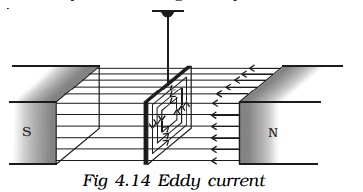Chapter: physics 11th 12th standard school college definition answer assignment examination viva question
Eddy currents and Applications of Eddy current

Eddy currents
Foucault in the year 1895 observed that when a mass of metal moves in a magnetic field or when the magnetic field through a stationary mass of metal is altered, induced current is produced in the metal. This induced current flows in the metal in the form of closed loops resembling ‘eddies’ or whirl pool. Hence this current is called eddy current. The direction of the eddy current is given by Lenz’s law.

When a conductor in the form of a disc or a metallic plate as shown in Fig 4.14, swings between the poles of a magnet, eddy currents are set up inside the plate. This current acts in a direction so as to oppose the motion of the conductor with a strong retarding force, that the conductor almost comes to rest. If the metallic plate with holes drilled in it is made to swing inside the magnetic field, the effect of eddy current is greatly reduced consequently the plate swings freely inside the field. Eddy current can be minimised by using thin laminated sheets instead of solid metal.
Applications of Eddy current
(i) Dead beat galvanometer
When current is passed through a galvanometer, the coil oscillates about its mean position before it comes to rest. To bring the coil to rest immediately, the coil is wound on a metallic frame. Now, when the coil oscillates, eddy currents are set up in the metallic frame, which opposes further oscillations of the coil. This inturn enables the coil to attain its equilibrium position almost instantly. Since the oscillations of the coil die out instantaneously, the galvanometer is called dead beat galvanometer.
(ii) Induction furnace
In an induction furnace, high temperature is produced by generating eddy currents. The material to be melted is placed in a varying magnetic field of high frequency. Hence a strong eddy current is developed inside the metal. Due to the heating effect of the current, the metal melts.
(iii) Induction motors
Eddy currents are produced in a metallic cylinder called rotor, when it is placed in a rotating magnetic field. The eddy current initially tries to decrease the relative motion between the cylinder and the rotating magnetic field. As the magnetic field continues to rotate, the metallic cylinder is set into rotation. These motors are used in fans.
(iv) Electro magnetic brakes
A metallic drum is coupled to the wheels of a train. The drum rotates along with the wheel when the train is in motion.When the brake is applied, a strong magnetic field is developed and hence, eddy currents are produced in the drum which oppose the motion of the drum. Hence, the train comes to rest.
(v) Speedometer
In a speedometer, a magnet rotates according to the speed of the vehicle. The magnet rotates inside an aluminium cylinder (drum) which is held in position with the help of hair springs. Eddy currents are produced in the drum due to the rotation of the magnet and it opposes the motion of the rotating magnet. The drum inturn experiences a torque and gets deflected through a certain angle depending on the speed of the vehicle. A pointer attached to the drum moves over a calibrated scale which indicates the speed of the vehicle.
Related Topics